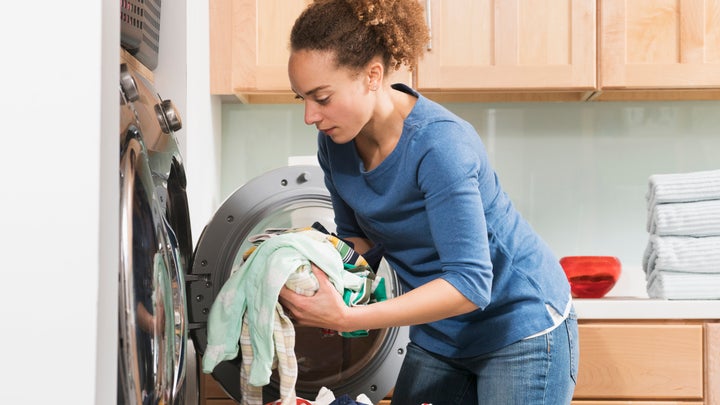They’re not only unnecessary, they’re also damaging in a few ways, experts say.
Still tossing in a dryer sheet every time you do your laundry? It might be time to leave that old habit behind.
You may have been using dryer sheets to soften, add fragrance or remove static from your clothing. But what you probably don’t realize is that those sheets are doing more harm than good to your clothes, your dryer and, most important, the environment.
First, dryer sheets don’t actually make your clothes any softer, although it might feel that way, said Patric Richardson of The Laundry Evangelist. The sheets are coated with a chemical solution that transfers to your garments when heated up during the dry cycle.
“It’s the coating that goes on fabric that feels soft,” said Richardson, the author of “Laundry Love.” “It’s the equivalent of putting a thick layer of lotion on your hand. Your skin isn’t actually softer, it just feels softer.”
Over time, that residue accumulates on your clothes. As lingerie expert Cora Harrington said in a Twitter thread in 2021, dryer sheets are “at best, absolutely useless” and, at most, “do actual damage to your clothes.”
“They work by putting a film of lipids and fragrances on your garments, which builds up over time and can contribute to clothing and towels smelling ‘musty’ or ‘stale’ even after they’ve been washed and dried,” Harrington, author of ″In Intimate Detail: How to Choose, Wear, and Love Lingerie,” told HuffPost via email.
“And if you share a machine, such as by using a laundromat — which I do — those lipids and fragrances can affect everyone else’s garments well.” (Plus, the scents and other ingredients in dryer sheets can be irritating to some people with asthma, allergies, migraines or sensitive skin.)
Stop using dryer sheets.
— Cora Harrington (@CoraCHarrington) November 20, 2021
This chemical coating can affect the properties of certain fabrics, too, said Sumit Mandal, an Oklahoma State University assistant professor who specializes in textile science. For example, it can make towels less absorbent, make your athletic gear less moisture-wicking and reduce the flame resistance of some children’s sleepwear.
That film also builds up in your dryer, which will can affect the appliance’s effectiveness over time, Richardson said. One example: The residue may prevent the electronic moisture sensor in the drum from working correctly. This can lead to over-drying and increase your utility bill, according to The Spruce. And be warned that the buildup can also coat the mesh of the lint catcher, making it a potential safety concern down the road.
Dryer sheets aren’t just a waste of money, they’re wasteful, too.
“They’re litter,” said Harrington, noting they can’t be reused and don’t decompose easily. “When you consider that many people use at least one dryer sheet — and sometimes much more — that’s a lot of trash.”
What To Use Instead

The most popular alternative to dryer sheets are wool dryer balls. They bounce off of your clothes and linens, softening the fibers, and are considered a more sustainable option because they can be reused many times — up to a few years, depending on how often you do laundry.
“You just toss them in the dryer with your damp laundry and let them get to work,” Harrington said. “People often find their clothes dry faster with wool balls, and, of course, unlike dryer sheets, they’re reusable and biodegradable.”
Because wool balls cut down on drying time, your clothes aren’t being subjected to high temperatures for as long. This — in addition to the fact that they don’t leave a chemical residue — also makes them a better choice to preserve the longevity of your garments.
However, if you’re allergic to wool or avoid it because you’re vegan, there are also reusable plastic versions.
Another thing to be mindful of: People tend to use far more laundry detergent than they need to. Using too much can make clothes feel “crunchy,” Richardson said, which can leave you reaching for the fabric softeners and dryer sheets. If you use less detergent to begin with, then your clothes will stay softer without needing to introduce additional products.
And while wool dryer balls may help some with static cling, Mandal and Richardson said you can also try using a ball of aluminum foil. Take a few feet of foil, crumple it up until it’s roughly the size of a tennis ball and toss it in your dryer with your clothes. You can reuse the same ball dozens of times, and you’ll know it’s time to replace it when it’s been reduced to the size of a walnut, Richardson said.
Harrington prefers to keep her laundry routine as simple as possible. She recommends using nothing in place of dryer sheets (but wool balls “if you must”). She believes clothes don’t need to be “highly fragranced” — they can “just be clean.” These small tweaks to the way you do and think about laundry can have a big effect in the long run.
“Something like avoiding dryer sheets is easy to do yet makes a significant difference in the quality and longevity of your clothing,” Harrington said. “I don’t think sustainability or making better fashion choices has to be some complicated, onerous thing. You can begin with very accessible steps.”
Credit: Source link